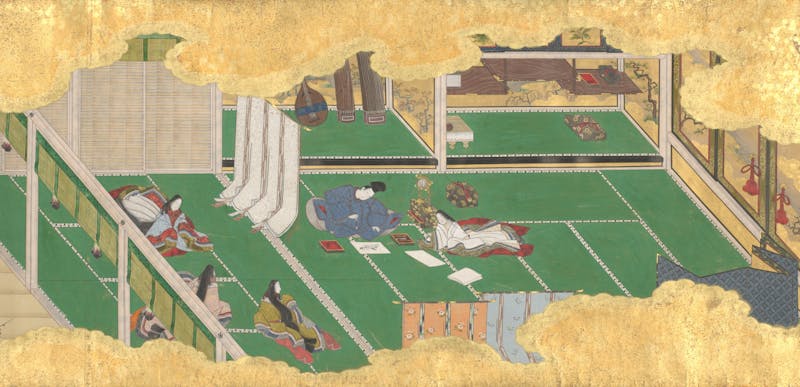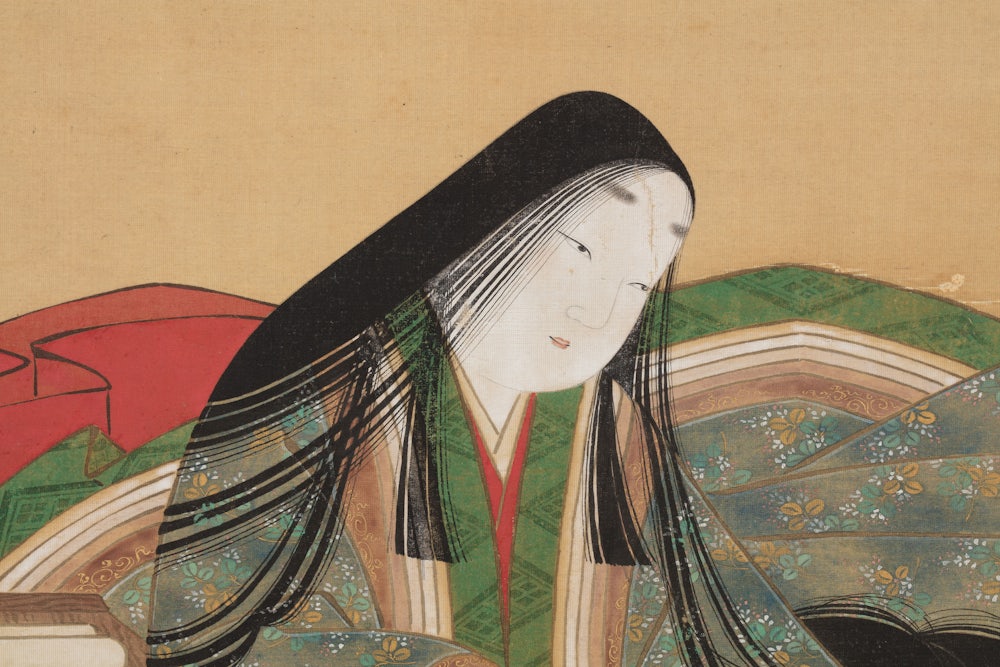The first thing you need to know about the titular character of The Tale of Genji, the world’s first novel, a thousand pages completed in Heian-period Japan around 1021 CE, is that he is hot AF, as they say on the Internet. Prince Genji, a secondary son of the emperor who is made a commoner so he won’t be threatened at court, is possessed of an astonishing beauty from birth. A traveling physiognomist declares him “destined to become the father of his people.” His nickname is The Shining Lord. Genji is so hot that men repeatedly wish he was a woman (Heian beauty standards ran androgynous). He excels at literally everything from playing the stringed koto to collecting paintings and writing poetry, not to mention constantly seducing women with his immaculate taste, only to kind of ignore them after installing them in a mansion somewhere.
In the Heian period, when Buddhism was first becoming the land’s principal religion, beauty was a moral force: The more beauty in this life, the better karma the person must have had in a previous life to deserve it, and vice versa. The best poem, painting, color-coordinated robe—these were all aesthetically as well as spiritually appealing in a kind of religiously validated, feudalist consumerism. And Prince Genji was the epitome of both.
In a dim, sectioned gallery like the chambers of a traditional Japanese house, the Metropolitan Museum has collected a Genji-themed exhibition that’s as glittering and various as the novel itself, featuring illuminated scrolls, engraved book containers, and folding screens all depicting the book’s pivotal scenes. The artwork is the result of centuries of fandom, hand-copying the tale from one generation to the next. Genji’s Heian-ideal face—a round, pallid visage with high, bushy eyebrows and a pouty mouth—shines out from all of them. He was never emperor, but the fictional prince did become the father of his people (as well as some possibly illegitimate children) through art rather than politics. The exhibition presents the novel as a wellspring of culture similar to the Bible and western art, if Jesus had been all about promiscuous sex and choosing which incense to perfume your robes with based on the season.
Rather than life-or-death decisions, the vast majority of the characters’ trials center on quoting an appropriate poem or knowing when to follow up with an absent lover. The Heian conflation of taste, ethics, and identity, not to mention their preoccupation with sending each other poem fragments like so many text messages and then fretting about not getting replies, wasn’t so far off from our own era of late decadence, the 21st century. Of course, as in our own time, the placid aestheticism was also unsustainable.
Genji was written by Murasaki Shikibu, a noblewoman from the powerful Fujiwara family serving in the court of one of the empresses at the time, Empress Shoshi, in Heian-Kyo, now Kyoto. We don’t know her real name. Murasaki is adopted from the name of Genji’s principal love, thought to be a stand-in for the author, and Shikibu is derived from her father’s position. Yet she’s one of the most famous authors, especially female authors, of all time.
Unlike most Heian women, she had a father who made sure she was well-educated; she could read and write Chinese, the language of the government and thus of men. Yet she was an ambivalent participant in court life however closely she managed to observe it. Like many writers, she preferred “living all the time in a poetical world of my own scarcely realizing the existence of other people,” as she wrote in her diary. The inspiration for Genji legendarily came when Shikibu went on a pilgrimage (a popular mode of entertainment for bored noblewomen) to the Temple of Ishiyama and gazed out at the moon over Lake Biwa. Shikibu’s story made her a kind of literary saint; the ink stone supposed to be the one she used in Ishiyama is even on view at the Met like a Christian relic.

Throughout the Met exhibition, the author is depicted in large scroll paintings perched above a lap-height desk gazing out into the distance in a timeless depiction of writerly angst, perhaps wondering what Genji would get up to next. Her face is indistinguishable from those of her characters. What marks individuality in the illustrations is the sheer sumptuousness of garments and an apparent lack of mobility—only the most noble, idealized women are marooned by their dozen layers of robes and long black hair spooling out like ribbon on the floor. Style was also a prison. Looking at a refreshingly spare, monochrome ink-line painting of a late Genji chapter from the 13th century, the women appear as static and integrated into the room as the furniture.
The dominant mood of Genji is summarized in the Japanese phrase mono-no-aware—a kind of sigh over the pathos of things in the world, the poignant beauty of total ephemerality as outlined by Buddhist thought. Under the code of mono-no-aware, one must appreciate the cherry blossoms blooming and then falling; the bare branches in winter; and the way the rising moon casts shadows on a nighttime path, the better for a man to make his quiet exit from a woman’s room. Artists usually depict the characters in states of calm contemplation or discussion. This habit of consuming experiences as much as things—observing intricacies of time and space passing by—is millennial and Instagram-like, an impression heightened by the book’s episodic nature. Genji plays koto. He holds a poetry contest. His lover gets murdered by the ghost of his previous lover. His son steals a woman away on a boat. Etc.
Or maybe the appeal of Genji art is more like Tinder. You can sweep vicariously through the list of romances and choose which suits or represents you best. (In later centuries, courtesans were known to take the names of Genji’s famous love interests as pseudonyms.) At the Met exhibition, the viewer becomes a voyeur of voyeurs, a doubled gaze. Men are always cracking wooden shutters, drawing aside curtains, and peeking through fences to catch glimpses of women, as Genji does on a 17th-century folding screen. The scene is when Genji sees the child Lady Murasaki for the first time and falls immediately in love. The nuns caring for her think it’s kind of weird that he wants to adopt her at such an early age to eventually be one of his wives, but they go with it because Genji can ultimately do no wrong.
Throughout the novel, Shikibu compares her fictional scenes to visual art—landscapes are described as resembling paintings and gatherings of beautiful people inspire the desire to paint them. Maybe this was a way of grasping for a framework for the form she was inventing as she went along. The novel’s cult of potent images, as visually beautiful as any ekphrastic literature, is what makes it so enduring to this day. The exhibition ends with a manga comic version of Genji by Yamato Waki from 1989, a painting with the prince’s face floating beatifically above a cloudy horizon. It’s an illustration of the—postmodern? oblique?—chapter of Genji’s death, which Shikibu left blank.
The Heian court believed they were approaching the end of a Buddhist cycle of history and thus a kind of apocalypse. “Everything seems to be in a state of decline,” Genji observes at one point. They were right, in a way. The Heian period ended in 1185 as conflicts between relatively Spartan Buddhist warrior-monks escalated in the hills around Kyoto and eventually engulfed the city, leading to a new ruling family in the militaristic Kamakura period, who considered the Heians louche and immoral. It’s hard to argue with that, though Shikibu’s literature was gradually upheld as reflecting Buddhist values.
Mono-no-aware sometimes resembles a vast “lol nothing matters.” Dynasties end, people die, seasons pass, the blooms fade—the only constant is implacable change and the best one can do is observe it rather than attempt to halt its pace. Clouds often move through the Genji illustrations, stretches of blank space often painted in lambent gold leaf washing through buildings and obstructing forests. They seem to represent the unceasing flow of time and the ephemerality of human achievement, no matter how civilized.
This doesn’t amount to a coherent political analysis, of course. But reading and looking at Genji today is a lesson in the possibilities of beauty even as the world falls apart. Sure, Genji and his pals were relentless decadents, the .01 percent, first against the wall when the revolution comes. Shikibu only notices peasants enough to describe them as ugly and stupid. But the characters take joy in affixing a handwritten message to a blooming branch, in attending an all-night gossip session around a lit brazier on a porch, and in falling in and out of love. These are nice things to remember, the kind of fleeting sensual experiences that will last as long as flawed humanity. As Shikibu writes of Genji: “Despite himself he could not help seeing that that old habit of his, to suffer agonies for impossible desires, was with him still.”
